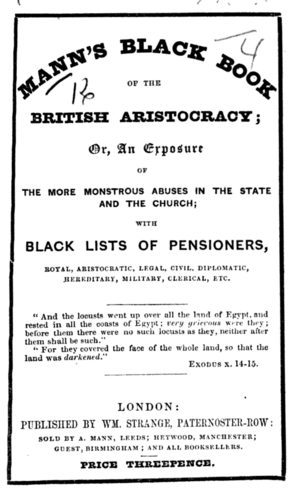Alice Mann (printer) facts for kids
Quick facts for kids
Alice Mann
|
|
|---|---|
| Born |
Alice Burnett
1791 |
| Died | 1865 (aged 73–74) |
| Occupation | Printer, publisher |
Alice Mann (born Burnett; 1791–1865) was a brave and determined woman from Leeds, England. She was known as a radical (someone who wanted big changes in society) and a publisher (someone who prints and sells books and newspapers). Alice faced challenges, including her husband being arrested. She also spent time in prison herself for selling newspapers without paying a special tax.
Contents
Who Was Alice Mann?
Alice Burnett was born in Leeds in 1791. When she was 16, in 1807, she married James Mann. James was a well-known activist and bookseller in the West Riding of Yorkshire. Their bookshop in Briggate was seen by some as a place where rebellious ideas were shared.
James Mann sadly passed away in 1832 from cholera. This left Alice as a widow with nine children to care for. She bravely continued the family business, selling books and adding printing to her work.
What Did Alice Mann Publish?
Alice used her printing business to share important ideas. In 1833, she published a book called Catechism of the Society for Promoting National Regeneration. This book aimed to fix social and business problems of the time.
She also published works by other important thinkers. These included Richard Carlile, a radical writer, and Richard Oastler, an activist. Alice even published a funny story about a politician named Edward Baines.
Later, in 1848, Alice helped publish Mann’s Black Book of the British Aristocracy. This book wanted to show unfair practices in the government and church.
Alice Mann's Fight for Change
Alice Mann and her family were involved in movements that wanted social change. In 1817, her husband was arrested because people thought he was part of an armed protest called the Pentrich rising. Luckily, he was released without any charges.
Alice herself faced legal trouble for her work. In 1834, she was sent to Wakefield Prison for a week. Her crime was selling newspapers that did not have a special government stamp, which was a tax.
In 1836, she was found guilty of the same thing again. She was fined a large sum of money. When offered a way out of prison if she stopped selling books, Alice refused. She bravely said she had no other way to support her family. So, she was imprisoned in York Castle for six months.
Alice was part of a group of printers and booksellers who believed in radical ideas. This network included people like Abel Heywood and William Strange. Alice was also involved in the Luddite movement (workers protesting against new machines) and the Chartist movement (people fighting for more rights for working-class people).
Books Published by Alice Mann
- Edward Hailstone, Catechism of the Society for Promoting National Regeneration (1833)
- William Rider, The Demagogue (1834)
- Samuel Smiles, History of Ireland and the Irish People (1843)
- S. H. Collins, The Emigrant’s Complete Guide to the United States, Australia... (1849–50)
- Bairnsla Foaks; Annual an Pogmoor Olmenack, be Tom Treddlehoyle (various editions)
- Charles Rodgers, Tom Treddlehoyle's Trip to Lunnan, to see Paxton's Great Glass Lantern (various editions, 1851-3)
- Edward Hailstone and Charles Rodgers, Tom Treddlehoyle's peep at t'Manchester Art Treasures Exhebishan (1857)
- Edward Hailstone and Alice Mann, Mann's Black Book of the British Aristocracy (1867)



